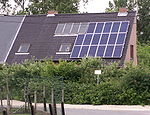m (Reverted edits by Samalmaairgy (talk) to last revision by 109.130.200.253) |
Samalmaairgy (talk | contribs) |
||
| (2 intermediate revisions by 2 users not shown) | |||
| Line 27: | Line 27: | ||
* http://en.wikipedia.org/wiki/Biohybrid_solar_cell | * http://en.wikipedia.org/wiki/Biohybrid_solar_cell | ||
* http://en.wikipedia.org/wiki/Dye-sensitized_solar_cell | * http://en.wikipedia.org/wiki/Dye-sensitized_solar_cell | ||
* [https://www.earthava.com/energy-harvesting-trends-2018/ Energy Harvesting Trends for 2018] | |||
{{Solar navbox}} | {{Solar navbox}} | ||
| Line 32: | Line 33: | ||
[[Category:Solar energy]] | [[Category:Solar energy]] | ||
[[Category:Electrical engineering]] | [[Category:Electrical engineering]] | ||
[[Category: | [[Category:Renewable energy]] | ||
[[Category:Energy conversion]] | [[Category:Energy conversion]] | ||
[[Category:Energy conservation]] | [[Category:Energy conservation]] | ||
[[Category:Energy production]] | [[Category:Energy production]] | ||
Revision as of 16:22, 16 June 2019

A solar energy conversion system (SECS),[1][2][3] or solar energy harvester are general terms that could be used for any machine that, powered by solar energy, either generates energy that can be used to directly heat a fluid or gas (passive solar) or generate electricity (PV, CPV, PETE, ...). The term can thus refer to:
- Thermal solar energy conversion systems (generally passive solar systems without mirrors or lenses),
- Photovoltaic solar systems (PV),
- Biohybrid solar cells,
- Dye-sensitized_solar_cells,
- Luminescent solar concentrators (a type of concentrated photovoltaics or CPV technology),
- Concentrating solar power systems,
- Photon Enhanced Thermionic Emission systems[4], ...
Operation
The conversion of the energy of the power of the sun into more useful forms is done using a variety of ways, each depending on the type of system employed. See photovoltaics.
See also
- Optimum orientation of solar energy harvesters
- energy harvesting
- Wind energy conversion system
- Thermal energy conversion system
- Hydro energy conversion system